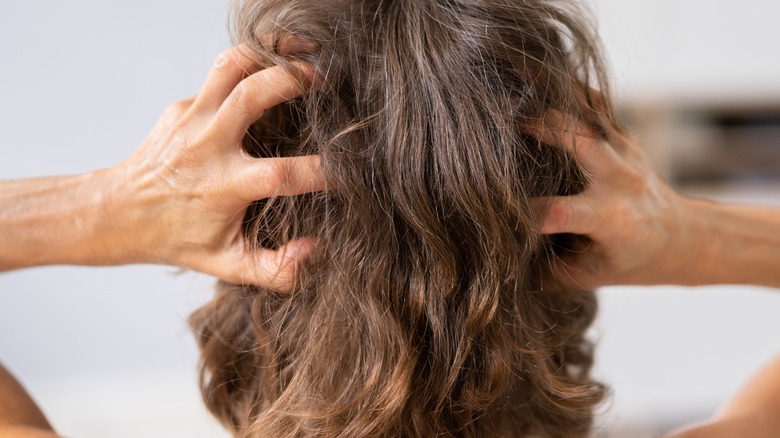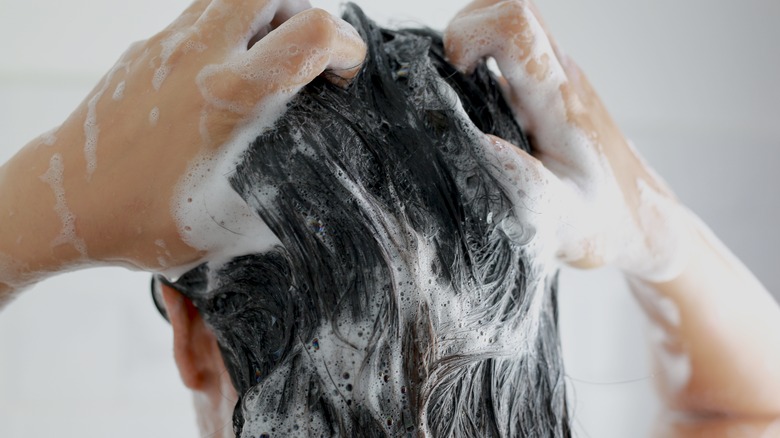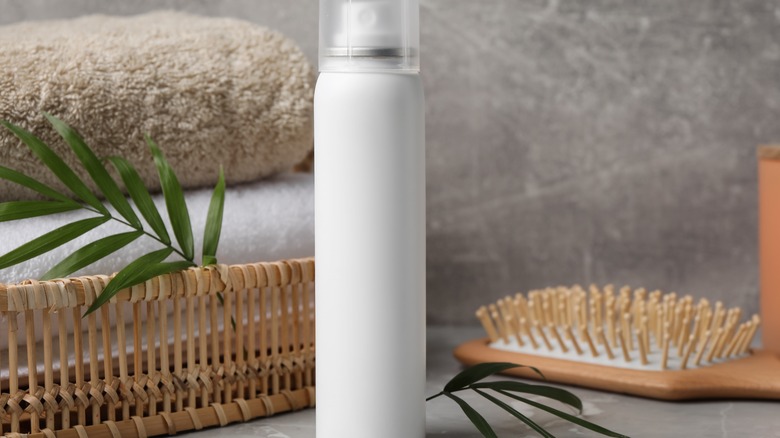Selenium Sulfide: Does The Dandruff-Fighting Ingredient Have A Dark Side?
Dandruff, a condition that causes the scalp skin to itch and flake, affects 50% of the world's population, according to a study published in the International Journal of Trichology. Dry or oily skin, yeast-like fungus, and allergic reactions to hair care products are some common causes of dandruff, according to Mayo Clinic. Although dandruff does not directly contribute to hair loss, it can feel uncomfortable and take away from your overall appearance.
As far as treatment goes, those with dandruff issues can find help in hair products specifically formulated for the management of a flaky scalp. Selenium sulfide-based shampoos as a case in point. According to MedlinePlus, selenium sulfide is an anti-infective component that effectively reduces itchiness and flaking of the scalp in addition to getting rid of the dry, scaly particles known as dandruff or seborrhea. That's why selenium sulfide is commonly found in many dandruff-fighting shampoos.
Although selenium sulfide is relatively effective in controlling the symptoms of dandruff to promote a healthy scalp, it is not without a dark side. Here's why improper use of selenium sulfide might take a toll on your hair and scalp.
Side effects of selenium sulfide
Per Medicover Hospitals, some typical side effects of selenium sulfide include oiliness or dryness of hair and scalp, hair discoloration, scalp irritation, and skin irritation. Selenium sulfide may, in the worst situation, result in hair loss. "Selenium sulfide can irritate, inflame and dehydrate the skin on the scalp that does not have outbreaks of dandruff. This can disrupt regular scalp and hair follicle function," Bridgette Hill, a certified trichologist and founder of Root Cause Scalp Analysis, tells Byrdie.
Echoing the sentiment, hair loss and restoration specialist William Yates points out that selenium sulfide can cause the scalp to be extremely dry and raise the risk of hair breakage, which is technically a form of hair loss. Your scalp has a microbiome, while selenium sulfide has antimicrobial effects. Prolonged use of such an ingredient can upset your microbiome and exacerbate your hair condition, trichologist Helen Reavey explains.
These side effects often go away on their own when your body gets used to the dosage. If you start noticing hair loss after using selenium sulfide, stop using it and your hair will grow back on. However, consider seeking medical treatment if your side effects persist. The best way to minimize side effects is to consult your dermatologist before using selenium sulfide, especially if you have a history of skin irritations or you're on medications.
"Use it episodically," cautions Yates. When used excessively, selenium sulfide can be more of a hindrance than a help.
How to use selenium sulfide
According to DermNet, low-strength selenium sulfide lotion and shampoo can be found in supermarkets or drugstores, higher strength formulations — say the 2.5% strength — are only available on a doctor's prescription. Selsun®, Exsel®, and Head and Shoulders Intensive Treatment® are some typical brand names of selenium sulfide solutions.
For a start, wet your hair and scalp with warm water. Then, apply one or two teaspoons of selenium sulfide shampoo to your scalp, according to National Institutes of Health. Trichologist Bridgette Hill advises using selenium sulfide only where you actually have dandruff, and preferably with a container that has an applicator that touches the scalp directly. After lathering the product up, let it sit on your scalp for two to three minutes before rinsing it out. Repeat the steps with a second wash. One of selenium sulfide shampoo's side effects is hair discoloration, so make sure you rinse the product out thoroughly after use. Once you're finished, wash your hands and nails thoroughly.
If you are using a 2.5% selenium sulfide shampoo, use it as instructed by your prescribing doctor. If you're using a 1% selenium sulfide solution, two applications each week for two weeks are recommended. If your dandruff symptoms do not improve after taking an anti-dandruff shampoo, seek out a dermatologist or a trichologist for an accurate diagnosis of your condition and guidance on the scalp treatments that best meet your needs.


